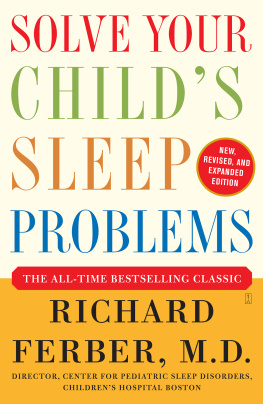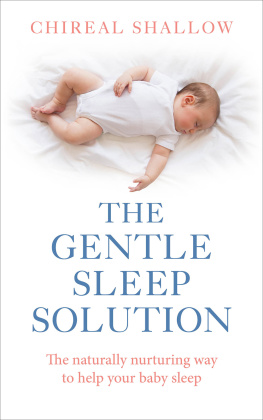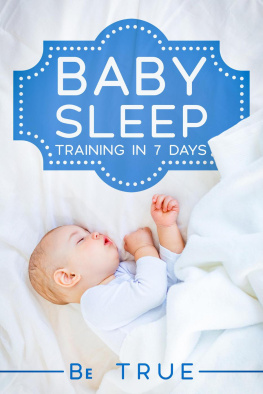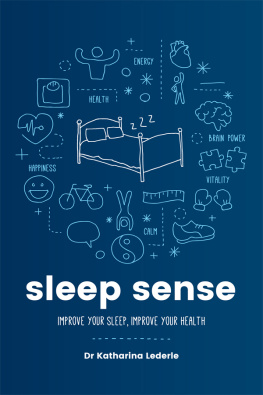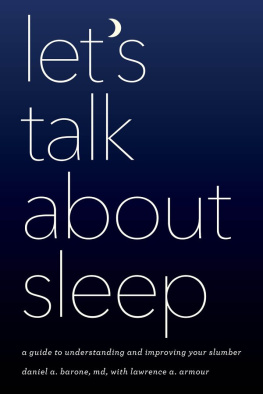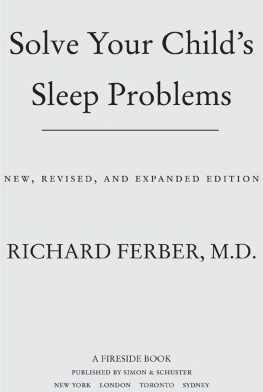Ferber - Solve Your Childs Sleep Problems
Here you can read online Ferber - Solve Your Childs Sleep Problems full text of the book (entire story) in english for free. Download pdf and epub, get meaning, cover and reviews about this ebook. City: New York, year: 2006, publisher: Touchstone;Fireside Book, genre: Children. Description of the work, (preface) as well as reviews are available. Best literature library LitArk.com created for fans of good reading and offers a wide selection of genres:
Romance novel
Science fiction
Adventure
Detective
Science
History
Home and family
Prose
Art
Politics
Computer
Non-fiction
Religion
Business
Children
Humor
Choose a favorite category and find really read worthwhile books. Enjoy immersion in the world of imagination, feel the emotions of the characters or learn something new for yourself, make an fascinating discovery.
Solve Your Childs Sleep Problems: summary, description and annotation
We offer to read an annotation, description, summary or preface (depends on what the author of the book "Solve Your Childs Sleep Problems" wrote himself). If you haven't found the necessary information about the book — write in the comments, we will try to find it.
Ferber: author's other books
Who wrote Solve Your Childs Sleep Problems? Find out the surname, the name of the author of the book and a list of all author's works by series.
Solve Your Childs Sleep Problems — read online for free the complete book (whole text) full work
Below is the text of the book, divided by pages. System saving the place of the last page read, allows you to conveniently read the book "Solve Your Childs Sleep Problems" online for free, without having to search again every time where you left off. Put a bookmark, and you can go to the page where you finished reading at any time.
Font size:
Interval:
Bookmark:
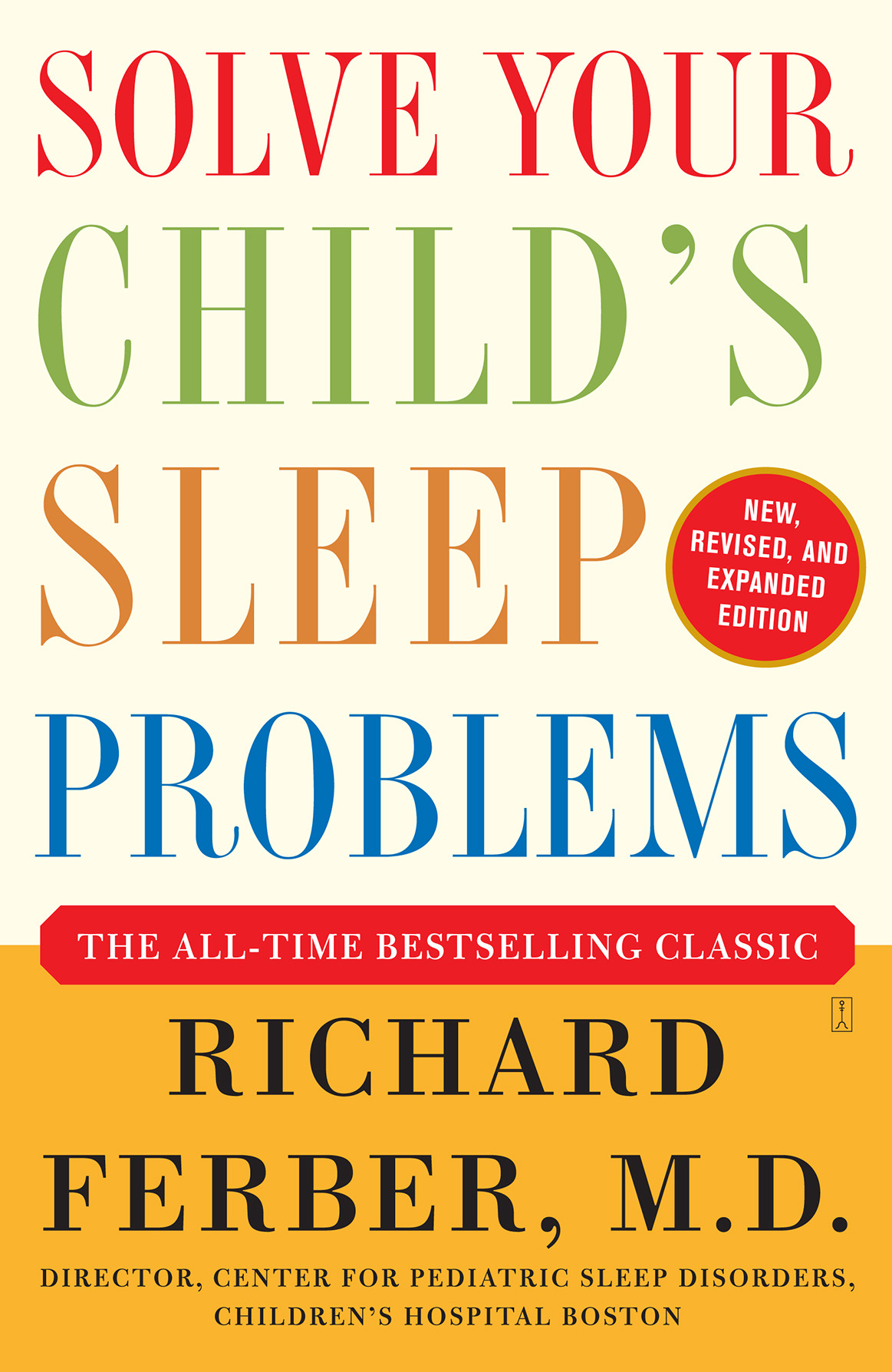


FIRESIDE
Rockefeller Center
1230 Avenue of the Americas
New York, NY 10020
Copyright 1985, 2006 by Richard Ferber, M.D.
All rights reserved,
including the right of reproduction
in whole or in part in any form.
FIRESIDE and colophon are registered trademarks of Simon & Schuster, Inc.
Designed by Jaime Putorti
Library of Congress Cataloging-in-Publication Data
Ferber, Richard.
Solve your childs sleep problems / Richard Ferber.Completely rev. and updated ed.
p. cm.
Includes index.
1. Sleep disorders in children. I. Title.
RJ506.S55F47 2006
618.928498dc22 2006041406
eISBN-10: 0-7432-1766-7
eISBN-13: 978-0-7432-1766-8
Visit us on the World Wide Web:
http://www.SimonandSchuster.com
To my sons, Matthias and Thaddeus.
As children, they taught me how to be a parent.
As adults, they have taught me to remember being a child.
I have gone to great effort to make the material in this book clear but not simplistic, rational but not dogmatic, and comprehensive but not encyclopedic. In so doing, I have had the great joy of working closely with my son Matthias. Matthias has taken these goals as his own and devoted considerable energies to the project with an ability far greater than mine. I can say for certain that if you find this book easy to read and understand, clear in its formulations and consistent in its approaches, resistant to misunderstanding, and straightforward to apply, then it is because of his efforts. Any mistakes in content remain my own.
When the first edition of this book appeared in 1985, the medical field devoted to the treatment of sleep disorders in children was new. Still, over the years, the basic information I presented on the nature of sleep and sleep problems in children has remained sound, and the techniques I described to help children with sleep problems have proven to be well conceived and practical. The value of these approaches has been confirmed repeatedly, not only at our sleep disorders center in Boston but at many othersand by many different professionalsaround the world. Most of the comments I have received from families who carefully read and then applied the techniques outlined in the first edition have expressed gratitude, with parents thanking me for helping them find a solution to a sleep problem that had been going on for months or years.
So why did I see the need, twenty years later, for this revised and considerably expanded edition? There are three main reasons.
The first reason is to correct some widespread misconceptions regarding my methods and their application. My goals have always been to help parents understand the nature of sleep and of childhood sleep problems, determine the causes of their own childs sleep difficulties, and choose or design an appropriate treatment program that fits their own philosophy of child rearing. I have always believed that the more you understand about your childs sleep problems, the more humane and effective you can be in solving them. A child may cry repeatedly each night, for example, but until parents understand why that is happening and institute proper treatment, they may be unable to resolve it in a way they find satisfactory.
Despite my efforts in the first edition to communicate these goals, it became clear that they were not always understood as I had intended. Many people thought I recommended a single method to treat all sleep problems, regardless of the nature of the problems, their causes, or the parenting styles and wishes of the family. Even worse, the particular method they refer to (only one of many approaches described in this book) has sometimes been incorrectly described as the same cry it out method that my suggested techniques were meant to counter. Simply leaving a child in a crib to cry for long periods alone until he falls asleep, no matter how long it takes, is not an approach I approve of. On the contrary, many of the approaches I recommend are designed specifically to avoid unnecessary crying. Most of the sleep problems discussed in this book can be corrected without any crying at all or, if the child is already crying at night, by rapidly reducing it. In the one case where some crying may be necessarywhen undesirable nightly practices or habits must be changedcrying can be kept to a minimum.
In this edition I have attempted to make it much clearer that there are many different sleep problems, that apparently identical sleep problems may have different causes in different children, and that a single sleep problem may have multiple contributing causes. To properly choose a treatment, one must take all these factors into account. Each problem and cause may require a different treatment (what works well for one problem may be inappropriate for another), and all component causes may have to be treated (a partial solution is no solution at all). In addition, often a number of treatment options are available, some of which fit a particular childs needs or personality and his or her parents desires better than others. I have tried to present more of these choices so that you, the reader, can find an approach you believe appropriate and are comfortable with, whether you live in a big home or small, sleep separately or together, or have one child or many; and whether your child is nervous or confident, cooperative or difficult, outgoing or shy.
The second reason for this new edition is to better address topics that were discussed inadequately in the original. Questions from parents have helped me identify topics that needed to be expanded, such as co-sleeping, naps, sleep problems in twins, and travel to different time zones. (The omission of co-sleeping from the original version, apart from a regrettably brief reference that only repeated the conventional attitude of the day, was unfortunate, given the importance of the issue to many parents.) This edition covers such topics in the detail they deserve.
Finally, in this revision I have added new information drawn from the last twenty years experience, study, and scientific discoveries. We now have more accurate information than we did in 1985 about childrens sleep requirements, and we know more about the biological clock and its effects on sleep and alertness, about sleep terrors and related problems, and about medical issues such as bedwetting, sleep apnea, and narcolepsy. Through my work with thousands of families, I can now offer a number of new methods for treating a variety of common sleep problems.
Sleep problems are rather complex by nature, and to understand and treat them, you need to know a little bit about how sleep works. Although you may be tempted to skip directly to the chapters describing a particular problem of interest to you, I suggest that you beginregardless of the type of sleep problem you hope to solveby reading the four general introductory chapters on sleep and sleep rhythms: the three chapters in Part I and Chapter 9, Schedules and Rhythms, in Part III. These chapters give you the background information you will need to understand most of what appears in other chapters.
You will be best equipped to understand any problem if you also read through most of the remaining chapters. At least skim through them quickly and go back for a closer read once youve identified the most relevant material. Many children have more than one sleep problem, and sleep problems are often interconnected. For instance, although the most common cause of sleeplessness in young childrenpoor sleep associationsis addressed in a single chapter, you may not be able to treat it successfully unless you take into account material from the chapters on limit setting, fears, schedules, or partial wakings. If your child has sleep terrors, you may need to understand the impact of habits and schedules on your childs symptoms before you can help effectively. And you cannot always deal properly with a problem of limit setting unless you also take into account your childs anxiety or an inappropriate bedtime.
Font size:
Interval:
Bookmark:
Similar books «Solve Your Childs Sleep Problems»
Look at similar books to Solve Your Childs Sleep Problems. We have selected literature similar in name and meaning in the hope of providing readers with more options to find new, interesting, not yet read works.
Discussion, reviews of the book Solve Your Childs Sleep Problems and just readers' own opinions. Leave your comments, write what you think about the work, its meaning or the main characters. Specify what exactly you liked and what you didn't like, and why you think so.

